
 |
Insung Jung
International Christian University, Japan
There have been few efforts to investigate the concept of quality from learners’ perspectives or to incorporate their needs and perceptions in quality standards in distance education. This is rather surprising, particularly in distance education contexts where the quality of the learning is not derived only from the products and services delivered to the learner but also from the knowledge, understanding, and relationships that are codeveloped by both teachers and learners during the teaching and learning processes. This study proposes and verifies a conceptual model of the 10 dimensions of quality in distance education from the learners’ perspectives and investigates gender differences in the perception of quality in distance education with 1,665 distance learners from 11 Asian countries and one territory. The results show that all 10 dimensions across supportive, pedagogical, and environmental domains in the model are important in judging quality in distance education. Also, gender differences are found in the perceived importance of 10 quality dimensions, barriers to DE, important supporters, and types of support received. The implications of these findings are discussed and suggestions for further research and development are offered.
Keywords: Distance education; e-learning; gender; learner’s perspective; quality
As Jung (2011) observes, the quality assurance (QA) criteria developed in various settings tend to be responsive to the perspectives of distance education (DE) institutions, assessors, and funding bodies and often ignore learners’ views on quality. For example, the E-xcellence Project’s e-learning assessment tool, which was developed under the auspices of the European Association of Distance Teaching Universities, includes 33 benchmarks that are mainly concerns of European e-learning institutions, including strategic management, curriculum/course design and delivery and support. Similarly, India’s Distance Education Council’s “Guidelines for Regulating the Establishment and Operation of Open and Distance Learning Institutions” requires DE institutions to attend to areas such as management of academic and administrative matters, policies and mechanisms for curriculum development, and staff training. Twenty-four common benchmarks for quality online education developed by the Institute for Higher Education in the USA also cover QA items important for e-learning providers to assess and improve their quality (Phipps & Merisotis, 2000).
While inputs from providers, assessors, and governments are valuable in managing and enhancing quality in DE as Frydenberg (2002) argues, learners’ views also need to be taken into account since the success of DE does not derive only from the products and services delivered to the learner but also from the knowledge, understanding, and relationships that are codeveloped by both learners and teachers during the teaching and learning processes, and such success typically relies to a greater extent on learners’ motivation and commitment (Ehlers, 2004; Jung, 2011; Tucker, 2010). Moreover, in order to improve learning experience and performance of distance learners, it is essential to fully understand their perceptions of quality DE.
Some studies have examined learners’ views on quality in DE and are well documented in Jung (2011). For example, employing a survey, focus groups, interviews, and case studies, Cashion and Palmieri (2002) investigated Australian learners’ and educators’ views on the quality of online learning. Flexibility, or a flexible way of utilizing e-learning technology, was rated as the most important factor in quality e-learning by learners, while it was rated far lower by providers. Other quality factors cited as highly important by most educators, such as induction, communication with teachers and other students, and a hybrid mix of face-to-face and online learning, were rated as less important by the learners. In particular, learners did not indicate any need for a lot of induction, initial support, or technology training to study online, while educators believed that they would demand far more support.
In a European context, Ehlers (2004) found from interviews with experienced e-learners that European learners see course process–related dimensions, such as presence, didactics, and collaboration, as more important than institutional considerations, such as vision, planning, and finance, in evaluating e-learning quality. He also uncovered that while e-learning institutions view technology as an important factor in enhancing the quality of e-learning, learners do not agree with this view and perceive technology as important only when it is lacking. This result is consistent with the findings from Cashion and Palmieri (2002) and Jung (2011) that e-learners do not see technology or technology support as a critical factor in assessing the quality of e-learning. However, as Muilenburga and Berge (2005) and Selim (2007) report, e-learners with poor technology infrastructure and less experience with technology perceive problems with technology and access as serious barriers to e-learning.
In the United States, Ward, Peters, and Shelley (2010) reported the positive perception of both instructors and students toward the overall instructional quality of synchronous online learning. They found that instructors were pleased with the quality of student-to-instructor and student-to-student interaction in synchronous online classes, while students positively assessed the quality of learning experiences during online learning.
Jung (2011) found that South Korea’s e-learners perceived staff support to be the most important indicator of e-learning quality, followed by institutional QA mechanisms and learning tasks. This finding clearly differs from the findings in the two Western studies mentioned above and may reflect the tendency for education in Asia to be more teacher-centered—a reminder that cultural factors also need to be taken into account when considering learners’ needs. However, even in the same region, different findings have been reported. For example, in an edited book on DE in Asia (Baggaley & Belawati, 2010), Chen and Wang (2010) reported that Chinese online learners ask for more teacher-student and student-student interactions and flexible learning activities that offer guidance, while their institutions place more emphasis on provision of video lectures and multimedia resources and content design that follows a certain standardized procedure.
While these studies contribute to our understanding of learners’ perspectives on quality in DE, they also point to the fact that there can be some significant differences across different contexts that are dependent on learner variables such as gender. This is particularly true in Asia, where gender is an important variable explaining barriers to distance learning (Bhushan, 2008), intensity of technology use (Jamtsho & Bullen, 2010), motivation and confidence to continue distance learning (Janaki, 2006), perception of the quality of DE courses (Yawan, 2001), and use of supports (Taplin & Jegede, 2001). Thus, in order to fill the knowledge gap in the literature and provide useful references to devise a balanced and improved QA framework for DE in Asia, we need to understand Asian learners’ perspective of DE quality and consider learner differences, especially in gender.
The present study aims to investigate Asian learners’ perceptions about the quality of DE and examines gender differences in such perceptions in an attempt to understand Asian learners’ needs and concerns in assessing quality in DE and provide practical references for the improvement of existing QA frameworks for DE in Asia. DE in this study includes various forms of technology/media-supported education such as e-learning.
To develop an initial list of quality dimensions for use in the study, relevant previous studies were analyzed. In particular, the categories confirmed by Jung (2011) in an Asian context served as a foundation to create and define six dimensions.
Four other dimensions (infrastructure, course development, teaching and learning, and evaluation and assessment) were added to the list as they were found to be common dimensions of Asian countries’ QA systems for DE. Jung, Wong, Chen, Baigaltugs, and Belawati (2011) analyzed the existing QA frameworks in the identical Asian countries and one territory, excepting Thailand, and found that vision and mission, educational resources, infrastructure, course development, teaching and learning, student support, and evaluation and assessment are commonly included as QA areas in Asia. Among these common QA areas, the vision and mission area was excluded since it was not identified as a major quality concern for Asian DE learners in several studies, such as Chen and Wang (2010) and Jung (2011). Student support had already been included among the QA criteria of the present study, and the educational resources area was incorporated in the course development dimension. Thus the remaining four dimensions were added to the list of the present study.
Once these 10 dimensions are identified, a model for quality in DE is built on three domains: supportive, pedagogical, and environmental. The three domains are used to categorize and organize the 10 dimensions in a meaningful and efficient manner.
In the model, gender, amongst several learner variables, is considered to be an important variable influencing Asian learners’ perception of quality factors in DE as the barriers and supports necessary for successful distance learning are quite different between male and female learners (Bhushan, 2008; Taplin & Jegede, 2001). Figure 1 presents the proposed conceptual model for quality in DE, depicting the relationships between the three domains and the 10 dimensions as well as the gender effect in the perception of quality in DE as perceived by distance learners.
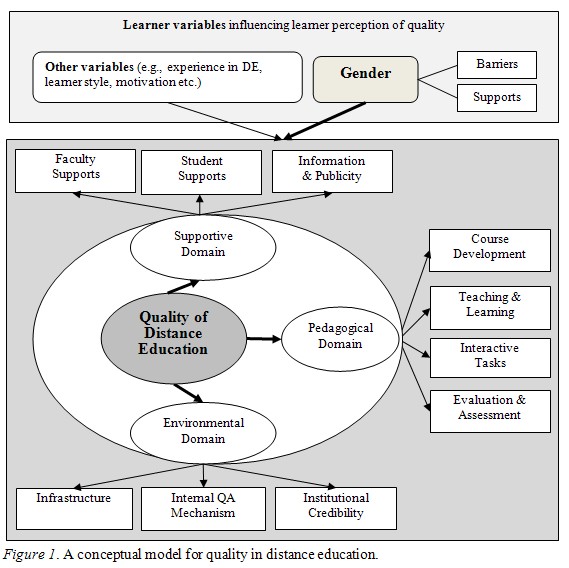
This study aims to (a) evaluate the factor structure underlying this conceptual model at the domain and dimensional levels; (b) identify important quality criteria within each dimension in assuring the quality of DE from the perspective of Asian learners; and (c) discover gender differences in learners’ perceptions of quality in DE, learning barriers, and supports. The aim of this is to contribute to a better understanding of the quality dimensions and criteria identified by Asian distance learners and gender differences in such perceptions and to offer Asian DE providers and policy makers practical guidelines on how to integrate learners’ perceptions and gender-considerate support strategies into their QA framework.
This study was carried out in Asia, which is home to the world’s largest number of learners studying at a distance. A survey was employed in the study to collect data from a large number of distance learners scattered across several Asian countries regarding their perceptions of DE quality that could not be directly observed.
Participating institutions or programs include the following:
The participants from these institutions or programs include individuals who were taking e-learning courses offered by foreign universities, for-profit companies, or community centers at the time of data collection.
A total of 1,665 learners who were enrolled in DE institutions or programs in 11 Asian countries and one territory (China, Japan, Korea, Hong Kong SAR China, Malaysia, Mongolia, India, Indonesia, Pakistan, Philippines, Singapore, and Thailand) participated in this study between June and October 2010.
Over 45% of the participants came from DE institutions or programs in five of the countries and from the one territory where English was used as a main medium of instruction, 18.5% came from Indonesia, where the number of DE learners has reached 650,000, and about 10% came from Korea, where over 250,000 are DE learners. While we had fewer participants from China and more from Mongolia in proportion to the number of DE learners in each country, a fair distribution of survey participants was achieved overall.
Sixty-four percent of the participants were male students and slightly over 50% were between the ages of 21 and 30. Almost 52% were studying at a local distance teaching university, while 29% were from a DE program offered by a local conventional university. Around 44% were using print as a main medium of learning and almost 21% were studying totally online, while over 72% had basic or advanced experience with DE. These figures seem to reflect features of average Asian adult DE learners, even though the proportion of male participants was a bit higher compared with that of most participating institutions (the most common male-to-female ratio among participating institutions was around 50:50). It is suspected that Internet accessibility for male students may have made it easier for them to participate in the online survey. Thus, caution is needed to interpret the data due to the difference in gender distribution. Table 1 shows demographic features of the participants.
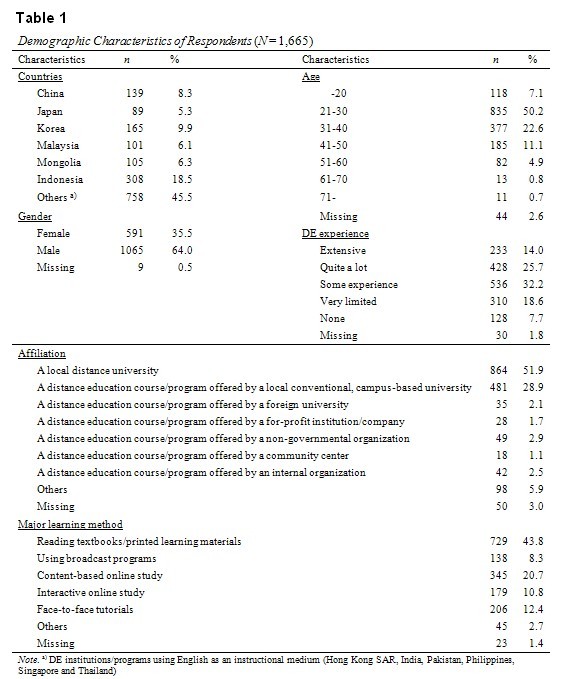
Based on the items confirmed by Jung (2011) and Jung et al. (2011), the initial 55 quality criteria across 10 quality dimensions were identified and refined to gain information about the learners’ perceptions of DE quality. This initial list was then reviewed by five DE experts in Asia (India, Japan, Korea, Malaysia, and Thailand) regarding the relevancy and validity of the items for measuring DE quality. As a result of this review process, three items were deleted from the initial 55 because of redundancy, nine were revised for clarity, and five new items were added to reflect the diverse DE situations in Asia. In all, 57 items were included in the final survey. The largest number of items (12 items) was generated in the teaching and learning dimension and the second largest (nine items) in the student support dimension since these dimensions were considered to be the core of DE. In the survey questionnaire, respondents were asked to rate each item’s importance in assessing and assuring the “quality” of DE (1 being lowest, 5 being highest). Additional questions were added to the questionnaire to obtain information regarding learner demographics, institutions, learning methods, study supports, and previous DE experience. In order to identify gender differences in barriers to distance learning and supports received to overcome the barriers, three more questions were asked.
The final English version of the questionnaire was translated into Chinese, Japanese, Korean, Mongolian, and Indonesian by the author and the project team, and one or two bilingual professionals in each country validated each of the respective translations.
First, an online survey site was created for the study. Since the study sought responses from distance learners from countries geographically dispersed throughout Asia, and all of the participating institutions used the Internet to communicate with their students, an online survey was believed to be more effective and efficient and better able to achieve large sample sizes. Concurrently, a printed version of the survey was prepared for those who could not access the Internet. Following a general ethics code for research, the survey proposal was reviewed by the Academic Affairs office at the author’s university, and an open statement that explained the purpose of the study, the benefits and possible dangers, the voluntary nature of the study, and the contact information was presented on the first page of the survey. Once the online survey site, which included six versions in different languages, was ready, an invitation email was sent out to DE educators teaching various subjects at different types of Asian institutions, including state-funded mega universities, small- and large-scale private DE institutions, DE programs offered by conventional universities, for-profit e-learning companies, and community centers and NGOs that were offering DE courses.
Multilevel confirmatory factor analysis (MCFA) via structural equation modeling (SEM) was carried out with AMOS 16.0 to address research goals (a) and (b). An independent-sample t-test, chi-square tests, and analyses of standardized residuals were conducted to identify gender differences.
The results of MCFA confirmed the goodness-of-fit of the conceptual model of quality in DE and revealed that all three domains and all 10 dimensions in the model were important in assuring the quality of DE from the perspective of Asian learners. As seen in Figure 2, standardized coefficients for the three domains were high (.941 for the environmental domain, 1.013 for the pedagogical domain, and 1.021 for the supportive domain), which indicates that all three domains are highly important in assessing quality in DE. In the supportive domain, the student support dimension was the best indicator explaining DE quality. In the pedagogical domain, evaluation and assessment and course development were the two most influential dimensions, each explaining between 83% and 84% of the variance of the domain. In the environmental domain, the infrastructure and institutional credibility dimensions were powerful indicators of DE quality as perceived by the Asian learners, and each explained about 85–86% of the domain’s variance.
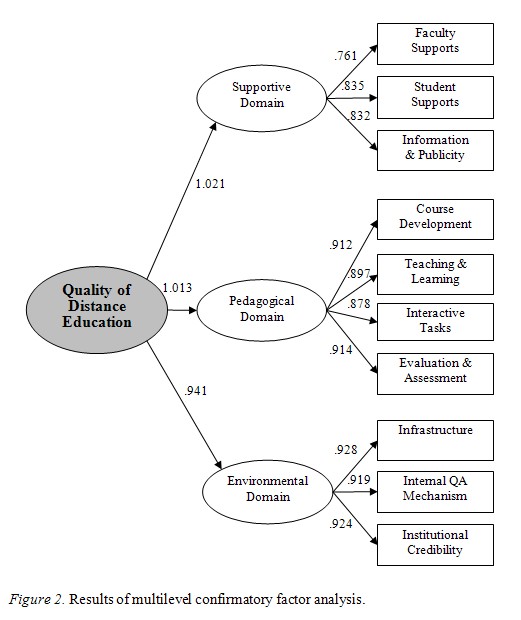
Several indices were calculated to assess the goodness-of-fit of the model constructed of three domains and 10 dimensions. As Bentler (1990) cautions, the chi-squares (χ2) statistic is highly sensitive to sample size to the extent that tests involving large samples, such as the one in this study, would generally lead to a rejection of the null hypothesis even if the factor model is appropriate. Thus, in this study, the root mean square error of approximation (RMSEA) was employed because it is less sensitive to sample size and takes into account the complexity of the model and the degrees of freedom. As suggested in Byrne (2001), the RMSEA cutoff was set at .08 or less. Additionally, comparative fit index (CFI) and incremental fit index (IFI) were adopted to assess the fitness of the model. Values of these indices close to 1 indicate a very good fit between the data and the model. RMSEA = .74, CFI = .848, and IFI = .848 were obtained, indicating an acceptable fit of the model to the observed data set.
At the quality criterion or item level, the results revealed that factor loadings varied from .11 (physical classrooms) to .91 (providing course information). A low factor loading indicates that an item is perceived not or less important by the participants.
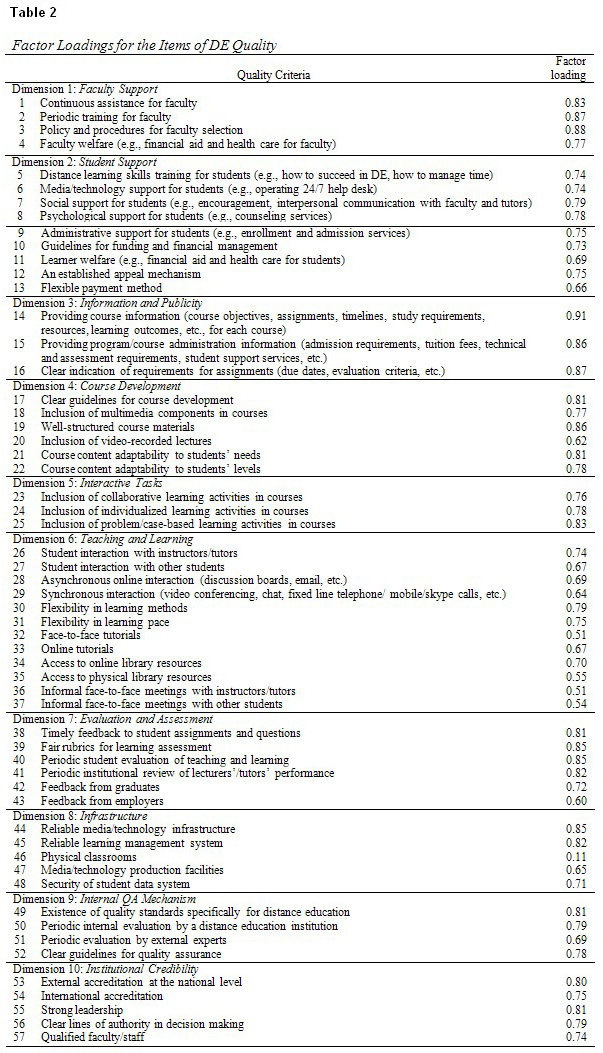
Independent-sample t-tests revealed that there were mean differences between the female and male participants in rating the domains and dimensions of DE quality. Tables 3 and 4 show that the female students perceived all three domains and 10 dimensions as being more important in assessing the quality of DE than did the male students.
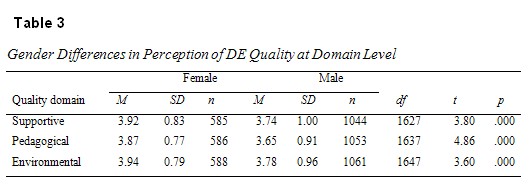
A chi-square test was conducted to see if any gender differences exist in the types of problems experienced or barriers while studying at a distance. For further comparison, an analysis of standardized residuals designed to overcome the problem of different variances among the raw residuals was conducted. In this analytical method, the actual frequencies of each item were compared to the expected frequencies. Table 5 shows that there were significant gender differences (χ2(9, n = 1632) = 35.870, p = .000). The analysis of the standardized residuals revealed that “Financial difficulties” was a more serious problem for male students, while “Conflict with family obligation” was more serious for female students. Some open-ended responses regarding concerns among the male and female students also confirmed this result and disclosed that for the male students the social and economic value (e.g., employment, promotion, increased salary, and recognition in society) of the degree earned through DE was another important concern.
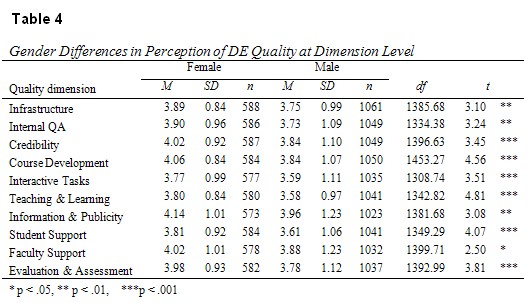
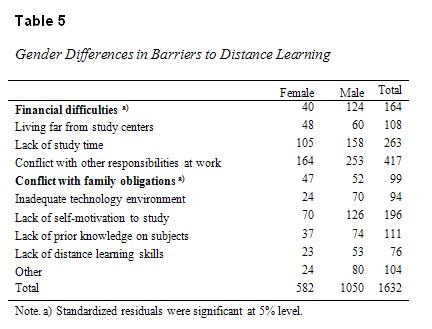
A chi-square test revealed significant gender differences in important support providers of distance learning, χ2(6, n = 1600) = 12.968, p = .044 (Table 6). The analysis of standardized residuals revealed that family members were more important support providers for the female students than for the male students, while academic staff and fellow students were equally important for both genders.
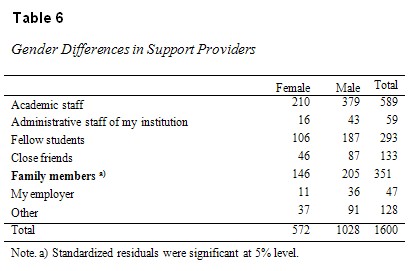
A chi-square test revealed that there were significant gender differences in supports received during distance learning, χ2(5, n = 1586) = 18.949, p = .002 (Table 7). The analysis of standardized residuals revealed that the male students received more academic support while the female students received more support socially, psychologically, and logistically.
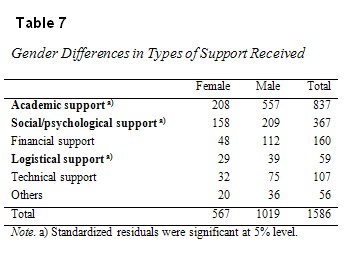
As de Guzman and Torres (2004) point out, any higher education institution should look at its quality issues from a total quality or systems perspective. Similarly, Ingvarson and Gaffney (2008) argue for the importance of considering and connecting all important components in the educational environment to aid in providing quality learning opportunities for learners. In this study, a conceptual model categorizing 10 dimensions in three domains is suggested to cover a total quality environment for the distance learner.
It is confirmed that the proposed conceptual model is appropriate in explaining Asian distance learners’ perception of quality in DE. All three domains and 10 dimensions proposed in the model appear to be important in explaining the quality of DE, and gender, amongst other learner variables, affects learner perception of DE quality. This finding suggests that the conceptual model proposed in Figure 1, along with the quality items presented in Table 2, contributes to an understanding of Asian learners’ perception of quality in DE and thus can be used to review, revise, and elaborate the existing QA frameworks of DE providers in Asia from the learners’ perspective.
In the supportive domain, the student support and information and publicity dimensions were quite influential in assessing the quality of the support aspect of DE in the eyes of the Asian learners. In particular, the distance learners perceived a DE institution or program that provides social and psychological supports and clear course information to be of high quality. This finding suggests that DE providers need to explore cost-effective ways of providing demand-driven and learner-centered supports that include detailed information regarding admission, course registration, finances, previous students’ opinions, opportunities provided by the program, and employment prospects (Ryan, 2004; Tao, 2008). A one-stop online portal could be a cost-effective referral center to provide technical, administrative, and academic services to DE learners, as suggested by Ryan (2004).
In the pedagogical domain, evaluation and assessment was the most powerful dimension in explaining DE quality. The learners saw fair and clear learning assessment guidelines and periodic students’ evaluation of teaching and learning as particularly important. This finding is consistent with previous studies, which highlight the importance of evaluation and assessment in assuring the quality of e-learning (Frydenberg, 2002; Lodzinski & Pawlowski, 2006) in the Western context, as well as with QA guidelines suggested by QA agencies in Asia (Jung et al., 2011), but contradictory to the finding from the study conducted with Korean online learners (Jung, 2011). While further research is needed to resolve this result, it suggests that Asian DE providers must pay attention to the development of detailed measures to assess the quality of their learning evaluation system and to use student evaluations for continuous quality improvement.
The dimension of course development was also influential in assessing the quality of the academic aspect of DE. “Well-structured course materials,” “Clear guidelines for course development,” and “Course content adaptability to students needs” appeared to be important in explaining the course development dimension, meaning that Asian learners perceive a DE program that provides well-structured course materials that follow clear development procedures and are considerate of learners’ needs to be of high quality. This finding confirms the arguments made by Phipps and Merisotis (2000) that quality online courses should be designed with a consistent structure and be adaptable to learners of varying learning needs and styles as well as the arguments made by Parscal and Riemer (2010) that course development guided by pedagogical principles is essential for a quality DE. However, while previous studies (Ho, 2005; Özkul & Aoki, 2006) report Asian learners’ preference for videoconference lectures or streaming video lectures, the Asian learners in this study did not agree that the “Inclusion of video-recorded lectures” was significant in assessing the quality of DE. This indicates that, even though the high-context Asian cultures generally value inferences through tone of voice, facial expression, body language, and the status of speakers (Latchem & Jung, 2009), today’s Asian learners value DE programs that offer greater flexibility and well-structured content that is adaptable to their needs rather than those that simply post video-recorded lectures on the Internet. Asian DE providers need to make an effort to develop well-structured course materials and at the same time allow students to choose course content and/or activities that are adaptable to their needs and learning conditions.
Pedagogical aspects such as teaching and learning and interactive tasks were found to be slightly less important compared with course development and evaluation and assessment but still powerful in measuring the quality of DE. As evidenced in several previous studies (Jung, 2011; Selim, 2007; Sun, Tsai, Finger, Chen, & Yeh, 2008), this finding also suggests that Asian DE providers should offer opportunities for learner-learner and learner-instructor interaction and real-world problem-based activities via both asynchronous and synchronous technologies. Such approaches can present greater opportunities for some passive Asian learners to engage in active and higher order learning. Recent Web development, including Web 2.0 technology, permits interaction and collaboration through weblogs, social networking sites, wikis, podcasts, and so on. All of these offer new educational possibilities, although they also raise issues of copyright, intellectual property, and the trustworthiness and authority of user-created content.
In the environmental domain, infrastructure appeared to be most important in assessing the quality of DE. Items such as “Reliable media/technology infrastructure,” “Reliable learning management system,” and “Security of student data system” registered strongly in explaining the infrastructure dimension. But “Physical classrooms” did not appear to be important at all in assessing the quality of DE. This finding highlights the importance for DE providers to ensure that dependable technology infrastructure is in place and to consider combining analogue and digital technologies as much of Asia is still constrained by limited infrastructure and skills, high costs, and slow Internet speeds (Baggaley, 2007).
The internal QA mechanism and institutional credibility dimensions also appeared to be influential in assessing the quality of DE, which was supported in Jung (2011) in the context of South Korea. “Existence of quality standards specifically for DE” appeared to be highly influential in explaining the internal QA mechanism dimension, and “Strong leadership” and “External accreditation at the national level” were the two most important items in explaining the institutional credibility dimension. As mentioned by several DE educators and researchers, including D’Antoni and Mugridge (2004), there has been a constant struggle for parity of esteem in DE. This study shows that in the eyes of the Asian learners both institutionalization of an internal QA system under strong leadership and recognition by external accreditation agencies are instrumental to securing parity of esteem. Asian DE providers need to develop the necessary policies and procedures for both internal and external QA together with the external QA and accreditation agencies.
Gender differences in the perception of quality in DE suggest a need for considering these differences in developing, delivering, and supporting DE. The study revealed that the female students, compared with the male students, perceived all quality domains and dimensions as being more important in evaluating DE quality. In addition, gender differences were found in the perceived barriers to and support for DE. These findings imply that even though DE has contributed to widening access to education and reducing the gender disparity in education, there still exists a lack of gender-considerate supports in Asian DE. “Conflict with family obligation” appeared to be the most serious barrier that the female learners faced, and family members were more important support providers for the female students than for the male students. This finding confirms Taplin’s (2000) conclusion that personal or family problems, including difficulties with caring for young children and difficulties with getting course materials in time to complete assignments or examinations, were the major problems for female students who were considering dropping out of their DE programs. Perhaps this is why the Asian female students received more support socially, psychologically, and logistically than they did academically.
There is no doubt that DE has broadened opportunities for underprivileged or marginalized people—women and girls in particular—to access education. In Asia, female enrolment in most mega and dedicated distance teaching universities is over 50% (e.g., 70% in the Korea National Open University and around 50% in the Open University System of China). However, in newly established e-learning institutions, female enrolment is lower, ranging from around 25% to 60% (e.g., 26% in the Virtual University of Pakistan and 58% in Korea’s Hanyang Cyber University), which may be explained by difficulties with technology access as noted in Bhushan (2008) or higher tuition costs in those e-learning institutions, which are mostly private. Green and Trevor-Deutsch (2002) observe that Asian women in DE face barriers when the course content is not directly relevant to their livelihood; when it does not value their knowledge, wisdom, and experience; when access to the content is too costly; and when they do not feel able to use the technology competently or confidently, which is supported by case studies that detailed how Asian female distance learners had overcome frustrations and succeeded in their learning (Kanwar & Taplin, 2001). For female learners, quality DE may mean a system that breaks down these barriers, that maximizes opportunity, and that is based on an understanding of their perceptions, concerns, and experiences, as Von Prümmer (2000) argues. The findings of the study suggest that Asian DE providers should consider these gender differences when designing their courses and support systems. For instance, social and psychological support that addresses issues of managing role conflicts and allocating focused time periods to accomplish learning tasks needs to be included in a support system for female learners.
With the competitive expansion of DE in Asia, Asian DE institutions must prove the quality of their courses, teaching, learning, and management systems for national and international accreditation. This increases their awareness of and responsiveness to the views and opinions of various stakeholders—not least of which are learners.
The conceptual model proposed and validated in the present study may contribute to a better understanding of Asian distance learners’ views on the quality of DE and offer a theoretical basis in examining distance learners’ perceptions in other regions. It can also serve as a framework for Asian DE providers and policy makers to integrate learners’ perceptions into existing QA systems in DE since their views highlight important quality areas that are not always reflected in the providers’ QA guidelines. In addition, it can be used to identify weak areas in DE operations from the learner’s point of view and suggest effective strategies for improving learner experience in DE. Further research is needed to investigate what specific strategies are effective in improving the quality of DE in general and the quality of learner experience specifically.
The study also leads us to the conclusion that Asian DE providers should consider gender differences when designing a learner support system. Some gender-considerate support strategies suggested in the study include offering flexible schedules that help distance learners, especially females, avoid time conflicts with other responsibilities in taking exams and attending face-to-face meetings, setting up virtual or face-to-face office hours to provide academic or learning content-related support to distance learners, offering both personalized counseling and tutoring services, especially to female students, and taking advantage of online technologies in providing such services, and providing information, especially to male students, on the values of degrees earned through DE based on policies and factual evidence.
One caveat of this study is that it combined all of the responses from the 11 Asian countries and one territory included and was not considerate of each country’s differences in terms of culture and DE systems. Therefore, the results of the study may not be applicable to each Asian country since great diversities with regard to learning culture, DE policies and development, technology infrastructure, support systems, and pedagogies exist throughout Asia. Even though the conceptual model included the existence of variables other than gender that might affect the perception of Asian DE learning, this study did not consider other learner variables, such as individual learning styles, preferences, and motivations, that may play important roles in the way learners feel, interact, and learn in DE and will clearly influence their assessment of the quality of such experiences. The design of the DE environment can also affect learners’ views on DE quality. Further research into these variables is needed.
This study was funded by the Openness and Quality in Asian Distance Education Project from the International Development Research Centre (IDRC) of Canada in 2010. The author acknowledges contributions of this project’s team members: Tat Meng Wong (Wawasan Open University, Malaysia), Tian Belawati (Universitas Terbuka, Indonesia), Chen Li (Beijing Normal University, China), and S. Baigaltugs (Mongolia University of Science and Technology, Mongolia) in survey development and data collection; and Aminudin Zuhairi (Universitas Terbuka, Indonesia), Aya Fukuda (International Christian University, Japan), and others for supporting the project.
Baggaley, J. (2007). Editorial: Distance education technologies: An Asian perspective. Distance Education, 28(2), 125–131.
Baggaley, J., & Belawati, T. (2010). Distance education technologies in Asia. New Delhi: Sage Publications India.
Bentler, P. M. (1990). Comparative fit indexes in structural models. Psychological Bulletin, 107, 238–246.
Bhushan, P. (2008). Connecting or dividing? Examining female learners’ information and communication technology access and use in open and distance learning. Journal of Open and Distance Learning, 23(2), 131–138.
Byrne, B. M. (2001). Structural equation modeling with Amos: Basic concepts, applications, and programming. Mahwah, NJ: Lawrence Erlbaum.
Cashion, J., & Palmieri, P. (2002). The secret is the teacher: The learners’ view of online learning. Leabrook, Australia: National Centre for Vocational Education Research. Retrieved from http://www.ncver.edu.au/research/proj/nr0F03a.pdf
Chen, L., & Wang, N. (2010). Attitudes to distance education in China. In J. Baggaley & T. Belawati (Eds.), Distance education technologies in Asia (pp. 111–126). New Delhi: Sage Publications India.
D’Antoni, S., & Mugridge, I. (2004, January 19–February 20). Virtual universities and transnational education: Policy issues – what are they? And whose are they? Paris: UNESCO. Retrieved from http://www.unesco.org/iiep/virtualuniversity/media/forum/vuforumreport_17may04.pdf
de Guzman, A. B., & Torres, J. R. (2004). The University of Santo Tomas viewed from the lens of total quality management: Implications to total quality education. Asia Pacific Education Review, 5(1), 88–99.
Ehlers, U. (2004). Quality in e-learning from a learner’s perspective. European Journal of Open and Distance Learning, 1. Retrieved from http://www.eurodl.org/materials/contrib/2004/Online_Master_COPs.html
Frydenberg, J. (2002). Quality standards in e-Learning: A matrix of analysis. International Review of Research in Open and Distance Learning, 3(2). Retrieved from http://www.irrodl.org/index.php/irrodl/article/viewArticle/109/189
Green, L., & Trevor-Deutsch, L. (2002). Women and ICTs for open and distance learning: Some experiences and strategies. Vancouver: Commonwealth of Learning. Retrieved from http://www.col.org/SiteCollectionDocuments/women%20and%20ICTs.pdf
Ho, M. L. C. (2005). E-lectures in teacher education: Boon or bane? Asian EFL Journal, 6, 1–26.
Ingvarson, D., & Gaffney, M. (2008). Developing and sustaining the digital education ecosystem: The value and possibilities of online environments for students. In M. Lee & M. Gaffney (Eds.), Leading a digital school (pp. 146–167). Melbourne: ACER Press.
Jamstsho, S., & Bullen, M. (2010). Development of ICT-based distance education in Bhutan. In J. Baggaley & T. Belawati (Eds.), Distance education technologies in Asia (pp. 57–85). New Delhi: Sage Publications India.
Janaki, D. (2006, October). Empowering women through distance learning in India. Paper presented at the Fourth Pan-Commonwealth Forum on Open Learning (PCF4). Retrieved from http://pcf4.dec.uwi.edu/viewabstract.php?id=329
Jung, I. S. (2011). The dimensions of e-learning quality: From the learner’s perspective. Educational Technology Research and Development, 59(4), 445–464.
Jung, I. S., Wong, T. M., Chen L., Baigaltugs, S., & Belawati, T. (2011). Quality assurance in Asian distance education: Diverse approaches and common culture. International Review of Research in Open and Distance Learning, 12(6), 63–83. Retrieved from http://www.irrodl.org/index.php/irrodl/article/view/991/1990
Kanwar, A. S., & Taplin, M. (Eds). (2001). Brave new women of Asia: How distance education changed their lives. Vancouver: Commonwealth of Learning.
Latchem, C., & Jung, I. S. (2009). Distance and blended learning in Asia. New York and London: Routledge.
Lodzinski, T., & Pawlowski, J. M. (2006). The quality mark e-learning: Developing process- and product-oriented quality. In U. D. Ehlers & J. M. Pawlowski (Eds.), Handbook on quality and standardization in e-learning (pp. 109–124). Berlin, Heidelberg, and New York: Springer.
Muilenburga, L. Y., & Berge, Z. L. (2005). Student barriers to online Learning: A factor analytic study. Distance Education, 26(1), 29–48.
Özkul, A. E., & Aoki, K. (2006, September). E-learning in Japan: Steam locomotive or shinkansen? Paper presented at the 22nd ICDE World Conference on Distance Education, Sao Paolo, Brazil.
Parscal, D., & Riemer, D. (2010). Assuring quality in large-scale online course development. Online Journal of Distance Learning Administration, 13(2), Retrieved from http://www.westga.edu/~distance/ojdla/summer132/parscal_riemer132.html
Phipps, R. A., & Merisotis, J. P. (2000). Quality on the line: Benchmarks for success in internet-based education. Retrieved from http://www.ihep.org/assets/files/publications/m-r/QualityOnTheLine.pdf
Ryan, Y. (2004). Pushing the boundaries with online learner support. In J. Brindley, C. Walti, & O. Zawacki-Richter (Eds.), Learner support in open, distance and online learning environments (pp. 125–134). Oldenburg: Bibliotheks und Informations system der Universität Oldenburg.
Selim, H. M. (2007). Critical success factors for e-learning acceptance: Confirmatory factor models. Computers & Education, 49(2), 396–413.
Sun, P., Tsai, R. J., Finger, G., Chen, Y., & Yeh, D. (2008). What drives a successful e-Learning? An empirical investigation of the critical factors influencing learner satisfaction. Computers & Education, 50(4), 1103–1586.
Tao, Y. H. (2008). Typology of college student perception on institutional e-learning issues: An extension study of a teacher’s typology in Taiwan. Computers & Education, 50(4), 1495–1508.
Taplin, M. (2000). Problems experienced by female distance education students of IGNOU: Why do some consider dropping out while others decide to stay? Indian Journal of Open Learning, 9(2), 191–210.
Taplin, M., & Jegede, O. (2001). Gender differences in factors influencing achievement of distance education students. Open Learning, 16(2), 133–154.
Tucker, A. (2010). Effective practices in e-learning: An online instructor and learner perspective. In J. Sanchez & K. Zhang (Eds.), Proceedings of World Conference on E-Learning in Corporate, Government, Healthcare, and Higher Education 2010 (p. 1251). Chesapeake, VA: AACE.
Von Prümmer, C. (2000). Women and distance education: Challenges and opportunities. New York: Taylor and Francis Group.
Ward, M., Peters, G., & Shelley, K. (2010). Student and faculty perceptions of the quality of online learning experiences. International Review of Research in Open And Distance Learning, 11(3), 57–77. Retrieved from http://www.irrodl.org/index.php/irrodl/article/view/867/1610
Yawan L. (2001). Wu Zhuhui: Sacrifice and perseverance. In A. Kanwar & M. Taplin (Eds.), Brave new women of Asia: How distance education changed their lives (pp. 11–13). Vancouver: Commonwealth of Learning.